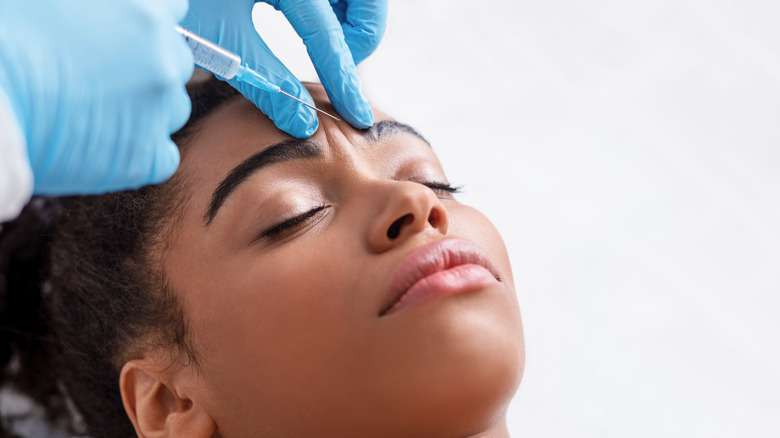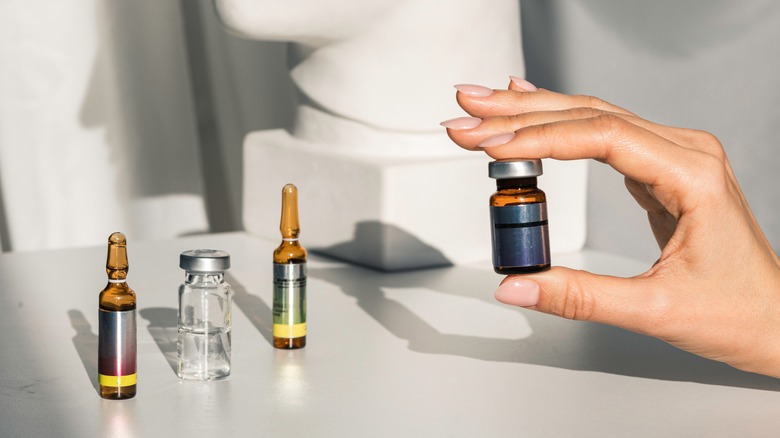What You Need To Know About Preventative Botox
Aging is a natural part of life, and it, of course, affects our skin. As you get older, you'll begin to notice more fine lines and wrinkles in the most expressive parts of your face — for example, around your mouth when you smile, above your eyebrows, or on your forehead. It is natural and absolutely meant to happen this way. While some people choose to embrace them in all their beauty, others choose to take a different route. In fact, some people try to get ahead of those fine lines and wrinkles before they begin to appear or get deeper.
Botox is usually a treatment performed at an older age when these lines have already made their mark and are already visible. However, some professionals in the industry are now saying that younger people should start treatment early, usually in their mid-20s or 30s, with what is called preventative Botox. This treatment is meant to be done before these visible signs of aging. "If Botox is injected during the initial stages of fine lines, it will help to stop them in their tracks," Dr. Debra Jaliman, a board-certified dermatologist, tells Healthline. "The ideal candidate is someone who has begun to see faint lines. When you see those faint lines, you're seeing a future wrinkle." But just how does Botox work as a preventative measure, and is it for everyone?
How preventative Botox works
According to Pure Aesthetics, Botox is a neurotoxin that comes from a bacterium called clostridium botulinum. It is usually found in nature, such as forests, lakes, and soil, but can be toxic if used too much at a time. Botox skin treatment is considered a safe procedure so long as it is done by a trained medical professional in the industry. The Botox used in skin procedures is usually a powder mixed with saline to be injected into the desired area. This is meant to weaken the muscles in that spot, which means they have less mobility. When they move less, they produce fewer wrinkles. Some doctors do warn, though, that it isn't meant to fully prevent wrinkles but rather postpone them.
Botox injections are often done in multiple sessions because they wear off in about three to four months. Each injection still works to help delay the aging process. "If I'm starting at 25, and I use it until I'm 40, then I've saved all of those years of not getting the wrinkles," Dr. Patricia Wexler, the founder of Wexler Dermatology, tells The New York Times. "So if you stop using the Botox at 45 or 50, you have a new baseline. You're going to get wrinkles at that point, but they're not going to be what you would have had."
Who can start preventative Botox?
Preventative Botox is meant to help prevent, or rather delay, the appearance of wrinkles and fine lines in the skin before they fully appear. However, some professionals note that starting this procedure before lines are visible might not be useful. Generally, people in their mid-20s to 30s will begin to see very faint lines indicating that a wrinkle is in the near future. This would be the ideal time to start preventative Botox. Dr. Shophie Shotter, the founder of Illuminate Skin Clinic, tells Harper's Bazaar that Botox is meant "to prevent the formation of lines and wrinkles, rather than in a corrective way once lines and wrinkles are already established." She adds that she will perform this treatment when the small hints of wrinkles-to-be slightly start showing up on the skin.
Meanwhile, Dr. Jennifer Owens, an aesthetic medicine professional at The Glow Clinic, tells Harper's Bazaar that people who are likely to get deep wrinkles due to genetics may also be candidates for this treatment. This applies to people whose mothers or grandmothers may have had deep wrinkles. Additionally, other people who could seek this treatment would be expressive people or those with thin skin.
While it is a medical procedure, keep in mind that if you are seeking to get Botox as a cosmetic or preventative treatment, insurance will not cover it. The cost will be expensive but will depend on how much you're getting and the experience of your injection provider (via Healthline).


